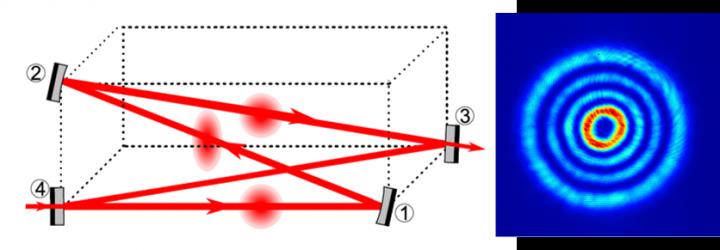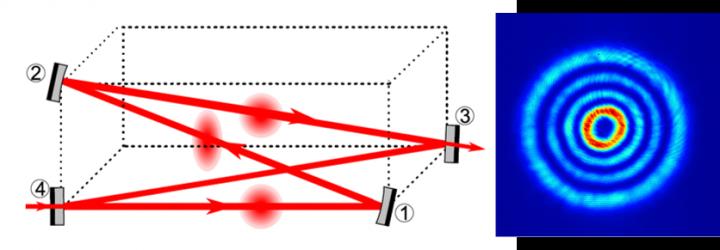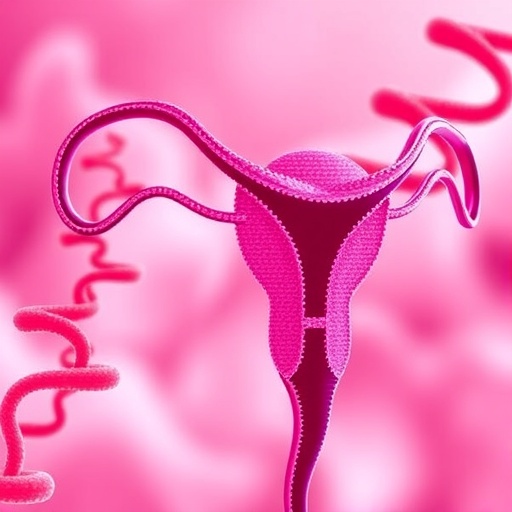
Credit: Andreas Noack, Albert Einstein Institute
WASHINGTON — Nearly one year ago today, the LIGO Collaboration announced the detection of gravitational waves, once again confirming Einstein's theory of General Relativity. This important discovery by the Advanced Laser Interferometer Gravitational-Wave Observatory (aLIGO) has spurred great interest in improving these advanced optical detectors. The mission of gravitational wave scientists worldwide is to make gravitational wave detection a routine occurrence. Scientists from the institute that developed the lasers used in Advanced LIGO have made significant progress to support that goal.
Advanced LIGO is a 2.5-mile long optical device known as an interferometer that uses laser light to detect gravitational waves coming from distant cosmic events such as colliding black holes or collapsing stars. Improving the stability of the laser source and decreasing noise that can hide weak signals coming from gravitational waves could help improve the sensitivity of gravitational wave detectors.
"We have made significant progress towards stable laser sources for third-generation gravitational wave detectors and prototypes of those," said Benno Willke of the Max Planck Institute for Gravitational Physics (Albert Einstein Institute) and Leibniz Universität Hannover, leader of the research team. "More stable lasers enable interferometers to sense gravitational waves that are weaker and from sources further away and thus reveal important insights into astrophysical events involving black holes and neutron stars."
The new work has been reported in two new papers in The Optical Society (OSA) journal Optics Letters.
Developing a more stable laser
Achieving stable and consistent laser power, with minimal noise, is crucial to the operation of sensitive laser-based instruments like gravitational wave detectors. The Advanced LIGO system uses a multiphotodetector array made up of photodiodes, which convert light into electrical current, to detect any power fluctuations in the laser and then correct these noise-inducing fluctuations using a feedback loop. A separate, identical multiphotodetector array is used to ensure the noise was reduced to the desired level.
"Although photodiodes are typically used to sense laser power noise, they can only accept around 50 milliwatts of light power each, rather than the 200 milliwatts a gravitational wave detector needs for sensitive noise measurements," said Willke. Albert Einstein Institute researchers overcame this problem by splitting the light beam among four photodiodes so that together, the array of photodiodes can accept the optimal amount of light and provide more sensitive noise detection.
To test the performance of the new multiphotodetector arrays, the researchers placed arrays identical to the ones used in Advanced LIGO into the AEI 10 meter prototype interferometer, a testbed instrument used for evaluating potential gravitational wave detector upgrades.
With the multiphotodetector arrays in the 10-meter prototype interferometer, the researchers demonstrated a laser power stability that was a factor of five better than what has been achieved by other groups. The stability matched closely to what they previously achieved in a tabletop laboratory experiment.
"This work shows that it's possible to transfer the stability level from the well-isolated environment of an optical table to a complicated experimental setup like this 10 meter prototype," said Willke. "We show that these photodiode arrays work as expected, meaning it should also be possible to achieve this high stability with the identical multiphotodetector arrays used in Advanced LIGO."
Laser beam shaping to reduce noise
Willke's research group also demonstrated that with a few minor modifications, gravitational wave detectors could be made more sensitive by using a laser in what is called a Laguerre-Gauss mode.
Advanced LIGO uses lasers in the standard Gaussian mode, which produce a solid circular beam like a laser pointer. Laguerre-Gauss mode lasers produce a beam that looks like a bullseye. Researchers have proposed using Laguerre-Gauss mode lasers in design concepts for a third-generation gravitational wave detector, known as the Einstein Telescope, which is expected to be 10 times more sensitive than today's instruments.
"The design of next-generation gravitational wave detectors is not fixed," said Willke. "Therefore, we are testing different types of lasers and demonstrating whether such lasers are available options for new gravitational wave detectors."
The researchers found that Laguerre-Gauss lasers are not compatible with devices known as "pre-mode cleaners" that Advanced LIGO uses to improve the stability of the laser beam. Andreas Noack, first author of the paper, discovered that the mirrors used in the mode cleaners cause a refractive error called astigmatism.
Utilizing a geometric trick to compensate for this error, the researchers built a modified pre-mode cleaner and showed that it compensated for the astigmatism and transmitted the Laguerre-Gauss mode even at the high laser power level used by gravitational wave detectors.
"This new type of pre-mode cleaner will make designs such as the Einstein telescope possible," said Willke. "We can only build these types of third generation gravitational wave detectors if we can build a laser source that can be used with those designs. We demonstrate here an additional step in the feasibility study for a light source that could be used in future gravitational wave detectors."
###
Papers:
J. Junker, P. Oppermann, B. Willke, "Shot-noise-limited laser power stabilization for the AEI 10m Prototype interferometer," Opt. Lett., Vol. 42, Issue 4, 755-758, (2017). DOI: 10.1364/OL.42.000755.
Andreas Noack, C. Bogan, B. Willke, "Higher-Order Laguerre-Gauss Modes in (Non-) Planar Four-Mirror Cavities for Future Gravitational Wave Detectors," Opt. Lett., Vol. 42, Issue 4, 751-754, (2017). DOI: 10.1364/OL.42.000751.
About Optics Letters
Optics Letters offers rapid dissemination of new results in all areas of optics with short, original, peer-reviewed communications. Optics Letters covers the latest research in optical science, including optical measurements, optical components and devices, atmospheric optics, biomedical optics, Fourier optics, integrated optics, optical processing, optoelectronics, lasers, nonlinear optics, optical storage and holography, optical coherence, polarization, quantum electronics, ultrafast optical phenomena, photonic crystals and fiber optics.
About The Optical Society
Founded in 1916, The Optical Society (OSA) is the leading professional organization for scientists, engineers, students and business leaders who fuel discoveries, shape real-life applications and accelerate achievements in the science of light. Through world-renowned publications, meetings and membership initiatives, OSA provides quality research, inspired interactions and dedicated resources for its extensive global network of optics and photonics experts. For more information, visit osa.org/100.
Media Contacts:
Rebecca B. Andersen
The Optical Society
[email protected]
1 202.416.1443
Joshua Miller vThe Optical Society
[email protected]
1 202.416.1435
Media Contact
Joshua Miller
[email protected]
202-416-1435
@opticalsociety
http://www.osa.org
############
Story Source: Materials provided by Scienmag





